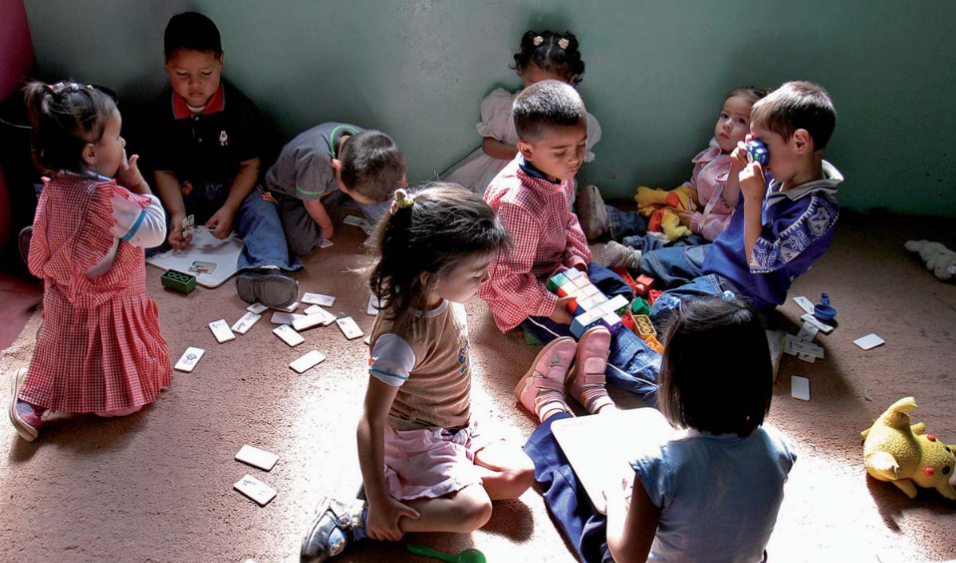Literacy is the cornerstone of education, but for many children, developing literacy means learning an entirely new language, one they do not speak at home. There are reasons for this: some countries have hundreds of local languages -- making the cost of creating learning materials for all languages high. But Mother tongue-based (MTB) education, teaching children literacy skills in the language they speak at home, has been shown to have benefits — societally, economically, and academically — which far outweigh the costs.
Mother tongue-based (MTB) education has shown to improve children’s literacy. MTB education takes place from pre-kindergarten and spans up to sixth grade. Children learn first in a familiar language and then gradually add a second language. When it is time to incorporate the second language, children who learn through MTB programs build on existing language skills to understand what they are reading, which, in turn, improves literacy rates. It is easier for children to read, write, and transfer words from their first language to their second language if they have a solid foundation in their mother tongue. A study done in fourteen African countries found that an early-exit model of moving from first language to second language instruction did not succeed, and that students needed a complete grasp on their first language before they could move on to a second one. Children in this study who moved too quickly to transfer from first to second language instruction performed at lower levels than before when they only learned in first language instruction.
MTB Education benefits society. In addition to education, MTB programs allow children to explore their full potential without being constrained by trying to express themselves in a second language. Without this barrier there is a greater opportunity to introduce quality contributions to society as a whole. A report by UNICEF found that MTB increases literacy and overall success in education, including the ability to pursue higher education more freely, and it improves “labour market access and ultimately produces greater economic productivity and competitiveness.” Moreover, governments with a greater focus on local languages see improved social progress, mobility, and capital. According to UNESCO's study on MTB education programs, children not only improve their literacy skills, but they also build greater self-confidence and cultural pride. For example, Inuit students who received instruction in their first language (Inuktitut) had higher levels of self-esteem compared to Inuit students who were only educated in their second language (English or French).
MTB education/programs are cost- effective in the long run. The benefits to MTB instruction are clear. So why isn’t it widely adopted worldwide? The major reason is the cost, namely of teaching and learning materials. But there are benefits of local language teaching and learning material production and there are ways to reduce costs.
According to the Global Book Fund Feasibility Study, some governments lack funding to procure textbooks in mother tongues despite the benefits it would have in the long run. In some cases, development partners step up to help with these costs; one example cited in the Feasibility Study was in the Philippines, where USAID funded $1.5 million in books and guides in selected mother tongues. But while MTB education may not appear to be budget friendly on the surface, research has shown it can be less costly in the long run. For example, a World Bank study in Mali found that French-only programs cost 27% more in a six-year primary school cycle than MTB programs. A study in South Africa suggested that if the country spent about five percent more of the education budget on MTB programs early on, they could expect those costs to be recovered within five to seven years. As of 2017, Guatemala’s savings were estimated to be over $5.6 million per year because the country made use of a MTB approach.
Also, a number of innovations can help to reduce costs. For example, Papua New Guinea developed a ‘shell book’ format which is a basic book format that leaves space for text to be filled in later. This allowed them to produce and publish books which could then be adapted for hundreds of languages. The Bloom Library and the Global Digital Library go a step further by providing simple platforms to create, read, and translate books into different languages. MTB policies can also offset costs by strengthening local book markets. The Global Book Fund Feasibility Study documented that Ethiopia’s turn toward policies such as MTB instruction has increased market opportunities for local publishers, who, unlike large international publishers, can profit financially off small print runs. Another example from the study is Tanzania's Child Book Project, which worked to strengthen local book markets by providing training while also purchasing half of the print runs at full cost, while the other half could be sold by publishers for a profit.
Although initial costs of MTB programs, particularly the procurement of teaching and learning materials, may be high, the financial savings from such programs far outweigh the initial investments by significant reductions in repetition and dropout rates, and the benefits to students with respect to literacy rates, self-confidence, and cultural pride, are lifelong.
Guest author: Merwa Koyash
References
Ball, Jessica. “Enhancing Learning of Children From Diverse Language Backgrounds: Mother Tongue-Based Bilingual or Multilingual Education in the Early Years.” UNESDOC Digital Library, 2011, unesdoc.unesco.org/ark:/48223/pf0000212270.
Bender, Penelope, et al. “Education Notes: In Their Own Language... Education for All.” The World Bank, June 2005, openknowledge.worldbank.org/bitstream/handle/10986/10331/389060Language00of1Instruct01PUBLIC1.pdf?sequence=1&isAllowed=y.
“Bloomlibrary.” Bloom Library, bloomlibrary.org/landing.
“Development of Shell Books.” SIL International, 16 Apr. 2018, www.sil.org/history-event/development-shell-books.
Feasibility Study: A Global Book Fund. 22 Oct. 2018, r4d.org/resources/global-book-fund-feasibility-study/.
Global Digital Library, digitallibrary.io/.
“Improving Learning Outcomes through Mother Tongue-Based Education.” Global Reading Network, RTI International, USAID, Aug. 2011, www.globalreadingnetwork.net/resources/improving-learning-outcomes-through-mother-tongue-based-education.
Lo Bianco, Joseph. “Synthesis Report: Language Education and Social Cohesion (LESC) Initiative in Malaysia, Myanmar, and Thailand.” UNICEF, 2016, www.unicef.org/Synthesis_Report_Language_Education_andSocial_Cohesion_Initiative.pdf.
Ouane, Adama, and Christine Glanz. “Why and How Africa Should Invest in African Languages and Multilingual Education.” UNESCO, 2010, files.eric.ed.gov/fulltext/ED540509.pdf.
Pinnock, Helen. “Steps Towards Learning: A Guide to Overcoming Language Barriers in Children's Education.” Save the Children UK, Save the Children, 2009, www.savethechildren.org.uk/content/dam/global/reports/steps-towards-learning-lr.pdf.
Photo Credit: Luz’s daycare centre, Bogota, Colombia, 2006
Photographer: Alejandra Vega Jaramillo © UNESCO

